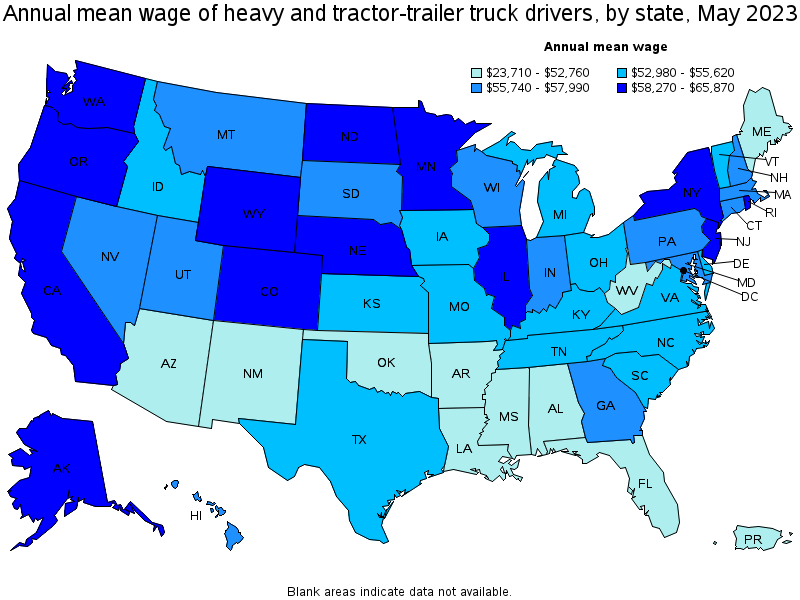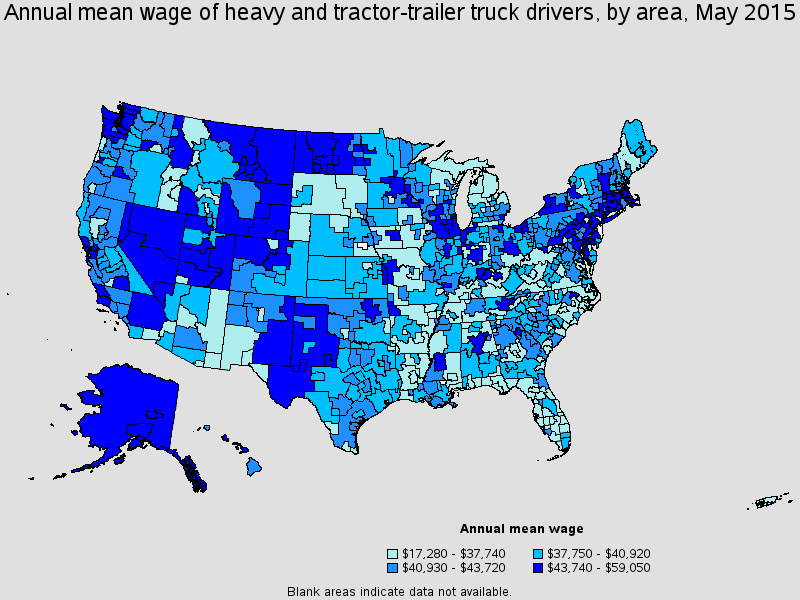How much do truck drivers make?
The definitive guide to pay for truck drivers
So, how much do truck drivers make? How much additional pay and income do they make in a year? Is there a high demand for this career, and what is the career future potential? All of these questions will be answered for you in this definitive guide on trucker pay and compensation.

An important differentiation
Discussion of pay structure for this career field brings up a need to clarify and differentiate the career path of a truck driver compared to other fields. If you are expecting the typical Monday through Friday 9 to 5 with weekends and holidays off, you need to pause and understand that this career field doesn’t usually operate in that fashion. Freight has to move at all hours and at all times, many times on a fairly tight schedule. Most drivers will describe this career as a lifestyle choice more so than just an occupation. Understand that common career progression is to begin your career with over the road long haul driving and after one to two years of experience branching off into something different if desired (like a local or regional job where you are home more often). This is not set in stone, and there are drivers who get hired directly out of school for local and regional, however: Most companies will want to see that one to two years of safe over the road experience prior to giving you your shot. Even the local jobs usually start with the driver getting up before the chickens do and hitting the road, many times putting in long hours. The tradeoffs of course are that you are out there on the road seeing many sites, getting paid a good wage, and being autonomous in getting the job done of moving freight from point A to point B without a boss breathing down your back. We like to give you the good and the bad so that you can compare and contrast and make an informed decision for yourself.
Career opportunity
According to occupational net (http://www.onetonline.org/link/summary/53-3032.00#WagesEmployment) , 2014 employment for heavy and tractor trailer drivers was 1,798,000. This is expected to grow between the years of 2014 to 2024 on average 5 to 8%. Projected job openings between 2014 and 2024 are 404,500. So as you can see, there is a large opening of positions available with a good average projected growth. Couple this with the fact that many drivers average age is in the mid 50’s and you have great potential for a career that is in demand and essential. There will be ample opportunity for entry and employment in this field.
Average and Median Pay
The occupational outlook handbook provided online by the Bureau of labor statistics shows a median pay level per year of $40,260, which translates to $19.36 per hour. Glassdoor, an online portal for employment surveys and information lists the national average truck driver salary at $43,464 per year. There are factors which affect these levels such as residency, experience levels, varied positions etc. all of which will be discussed below for further details.
Let’s take a look at two infographics provided by bls.gov which further breaks down the affect of state/locality of employment to annual wages:
Hover your mouse over the individual states for more Data:

Pic annual mean wage by state may 2015. Graphic provided courtesy of BLS
As you can see, wages vary depending on the location of employment. The darker blue states show higher wage levels in some of the western and north eastern states. The top five states and mean wages are as follows:
State | Annual Mean Wage | Hourly Mean Wage |
|---|---|---|
North Dakota | $53,400 per year | $25.67 per hour |
Alaska | $52,700 per year | $25.34 per hour |
District of Columbia | $49,190 per year | $23.65 per hour |
Massachusetts | $49.090 per year | $23.60 per hour |
Wyoming | $48,890 per year | $23.50 per hour |
The next infographic shows annual mean wage by area

Pic- annual mean wage by area May 2015. Graphic courtesy of BLS
This shows further that metropolitan areas break this pay structure down even further. The top five are:
Metropolitan Area
1. Nassua County-Suffolk County, NY
2. Bismarck, ND
3. Peabody-Salem, MA
4. Casper, WY
5. Danville, IL
For further detail see BLS link at: http://bls.gov/oes/current/oes533032.htm
Understanding and interpreting the numbers
Ok, so how do we make sense and usage of all these numbers and facts? There are several ways to use this data for your benefit. The first is to get an understanding of what may be influencing the numbers themselves. For example when you see the top two states for highest median annual wages, understand that in North Dakota and specifically the Bakken region there was an oil boom which inflated the wages and could be an influencer of pushing that State into the number 1 position. In addition, State #2, Alaska… well think about that one. Who hasn’t seen or heard about the ice road truckers and their high pay?
Two valuable lessons here….
First, are you in a position where you may be able to locate to a higher paying locale? If you are single or have a cooperative family situation you may be willing to look at relocating to one of these higher paying areas.
Second, as you will see below: Sometimes specialty freight and hauling boosts the overall pay that you will receive. See below for more details.
Pay Structure
So, what is the typical pay structure for someone hauling freight then? Well the industry standard as a driver is typically: Cents per mile or CPM. This can vary wildly, but what does this mean? It means that for every mile you drive and click over you will be compensated at a certain rate. There are three major types of miles paid. They are as follows:
Practical Miles, Hub miles, and Household Goods Miles commonly known as HHG.
Hub Miles

Hub miles are miles that the odometer turns, or of an actual hubometer that is mounted on the axle of the truck. These are actual miles that the truck is moving. The problem with this is that it has a potential to be abused if the driver is not completely honest. Example, they could take a ‘detour’ and add mileage to the trip. This type of mileage is not as common to be paid today.
Practical Miles
Practical miles are usually computed on a software program such as PC miler and are usually the most practical route that you would take to get to and from your destination. Most drivers’ state that you will be ‘shorted’ slightly vs the miles that you have actually driven.
Household Goods Miles
Household Goods Miles is usually a pre configured mileage amount established by the moving companies to quote rates. It has been described as “as the crow flies” directly. Drivers advise that it will usually translate as you getting paid between 5 to 10 % less mileage than you have actually driven.
Taking this into account, it should be put high on a list of questions to ask your recruiter. Of course we have made that easy for you, as you can download your free guide here…
Before we leave this section discussing cents per mile, let’s look at a few other variables:
Sliding scales…
Some companies (Knight Transportation comes to mind) pay on what is known as a sliding scale. This means that usually on the longer runs you get paid slightly less per mile than short hauls. If you think about this it provides an incentive to pick up shorter runs by receiving more per mile. The thought process is to make it more even out.
Here is an example of a sliding scale for a level three driver:
0-200 Miles | 200-300 Miles | 300-500 Miles | 500+ Miles |
|---|---|---|---|
$.38 cpm (cents per mile) | $.35 cpm | $.31 cpm | $.29 cpm |
Hourly Pay
Hourly pay is something that is usually offered to a local driver sometimes a regional driver for compensation and not usually for an over the road driver. A lot of this driving will be in city driving with multiple stops and is a rationale behind the hourly pay, as the miles don’t add up for the driver to make the pay feasible.
Other pay enhancements
There are several other specialty types of pay that can add to your overall compensation. We will first look at pay per mileage enhancements, and then look at lump sum payments.
Specialty Freight
Hauling specialty freight can have its benefits. One is an enhancement on the CPM that you get compensated. Some of the most popular are:
Flatbed: This is extra compensation for hauling flatbed freight. In addition you may receive additional pay in a lump sum for tarping loads (see below).
Refrigerated: Food and other perishables that need to be kept below a certain temperature require the usage of a reefer or refrigerated trailer. Extra compensation per mile is typical.
Hazmat: Extra compensation per mile may be granted for hauling hazardous loads.
Liquids/Tanker Trucks: Additional pay may be granted for hauling liquids such as milk, or gasoline etc. There is special handling required and in addition special procedures for offloading and sanitizing the tank after usage.
Oversize Loads: Extra pay may be granted for hauling oversize and wide loads as more care and consideration need to be given to make the transportation of these loads safe. Oftentimes escort vehicles, pre-approvals and coordination with public safety entities are necessary.
Vehicle transport: Transporting cars and trucks can be an interesting niche. Frequent work is obtained by moving the vehicles of seasonal residents, shifting new vehicles from ports or dealerships, and transporting exotic or rare vehicles.
Animal transport: Hauling livestock for food production, breeding purposes and even sporting events can pay more than average and starting wage.
Sporting event/Trade show/Bands: Nascar vehicles, Sports team equipment, trade show displays, and Band’s musical instruments and gear all present opportunity for enhanced pay and benefit.
Mileage Bonuses
In addition to hauling specialized freight you may get mileage bonuses for the following:
Safety: This pay will be granted, many times during a specific time period for safe operation of the equipment, not having any at fault accidents etc. It is usually paid as a penny or more per mileage driven during that time period. There are companies that pay a flat rate safety bonus in lieu of per mileage.
Fuel efficiency: This pay is dependent on meeting a company standard or goal for limiting fuel consumption. If you meet this minimum by driving carefully, utilizing cruise control, and not idling excessively you may get a per mile bonus pay for miles driven. Usually, like the safety bonus this will be per time period (example: quarterly).
Location pay: At certain times you may be asked to drive an area that is unpopular, more congested and difficult, or yes, even outside of the United States. In these situations you will usually be given an enhancement to the per mile pay. Several examples are deliveries to New York City, or some of the other densely packed cities such as Boston, Chicago etc. In addition, you will probably receive extra pay for delivering to Canada or Mexico (Don’t forget to bring your passport).
Team Driving: This is where two drivers haul freight and the truck is paid per miles driven. This arrangement is unique in that the CPM is divided amongst the drivers. So each individual driver may earn less per mile than someone who hauls solo, but you could look at it in addition that you are getting paid per mile even when not driving.
Lump sum bonus pay
Ok, let’s change gears (lol, nice trucker analogy right?) and talk about another type of pay; Lump sum enhancements. Below I will list the common types and give a definition or example of each:
Breakdown pay: If the vehicle/trailer breaks down and is out of service due to mechanical failure etc. after a certain period of hours or sometimes 1 day you are entitled to breakdown pay. This can be paid per hour or per day.
Layover pay: Waiting between loads for issues that are not the driver’s fault can result in being paid layover pay. Again, this could be paid as an hourly rate or a lump sum.
Detention pay: Many times your deliveries are scheduled for certain times. If you are there in excess of a certain amount of hours waiting (2 hours for example) you will be paid a certain rate per hour for your being detained at the shipper or receiver.
Multiple stops: When your load is scheduled to stop at multiple locations for delivery you may receive a per stop pay for this additional trip delay.
Load/Unload pay: Either driver completed or assisted you will usually receive compensation for loading/unloading and many times for assisting with the loading or unloading. This is usually in a lump sum.
Border crossing pay: Usually a lump sum for crossing into Canada or Mexico.
Hiring on bonus: If you are in demand some companies will give you a lump sum bonus for hiring on. This is usually either given in increments or after having stayed past certain agreed upon time.
Driver referral/recruitment bonus: For referring a driver to the company who is then hired on you can receive a bonus.
D.O.T. inspection bonus: If you are ‘lucky’ enough to be chosen for a D.O.T. inspection and have passed, many companies will give you a bonus for keeping your equipment in proper working order and functional.
On time delivery bonus: Some will offer this as an incentive to make your deliveries on time and on schedule.
Tarping Loads: Securing your load to a flatbed trailer. This activity is usually given a bonus amount.
Reimbursement pay
The next type of pay to discuss is reimbursement pay. This can take the following forms:
CDL School reimbursement: This is where you have already completed and paid for CDL School on your own. This pay is usually given per week or per month for reimbursement of CDL School. Some companies will reimburse up to $6000 dollars for your CDL training that you took. Keep in mind that this is paid out until either paid to the agreed upon amount or until you leave. In addition, this reimbursement pay is usually only paid by the first company who hires you directly after CDL School, so if you change companies the next will usually not pay you no matter how much, or how little you received with your first company.
Tolls and parking fees: At times you will be issued with prepaid passes for tolls depending on company policy. If you are required to pay tolls or parking fees, this will often be reimbursed.
Parts and Additives: If you are required to come out of pocket for any parts to the truck and trailer, they will usually be reimbursed. For additives, these usually include: oil, grease, lubricants, and fuel additives.
Scales: It’s very important that you aren’t overweight on any of your axles and therefore most truck stops and many facilities have scales that check the weight on each axle. If you pay for this service you will usually be compensated by your company.
Truck wash: Reimbursement for keeping the truck and trailer washed and cleaned. After all, it is a rolling advertisement for the trucking company and its appearance is reflected on you and the company you drive for.
Branching off on your own
This is a huge topic in and of itself, and one that I will more than likely devote an entire article to just by itself. Suffice to say that after gaining some experience and knowledge of the career field, you may want to branch off on your own and become an owner operator or lease operator.
Essentially you are starting a business by providing either a truck you own or lease to move freight. All the variables that come with having a business are present.
Equipment payments, operating expenses, insurance, fees etc. are all part of the decision to be your own boss. There is the potential to make a much larger amount, but with a higher reward always comes a higher risk. Look for future articles on this subject and use the information to make your own decision.
In Summary
So, how much do truck drivers make? As you can see, the answer to that question lies buried amongst a thousand variables. Suffice to say, that this guide should give you – the aspiring King (or Queen) of the road an idea of what type of pay can be expected yearly as well as the other variables that can enhance that pay. There is a great need to move freight across this country and that need will always have to be filled in one fashion or another.
Look for our future articles on Owner-Operator trucking and our Company profiles for more specific details on pay and benefits.
In addition, be sure to pick up our FREE guides on:
6 Hacks for boosting pay as a new Truck Driver
Avoiding the 11 biggest mistakes before starting CDL School
And our Cheat sheet checklist of what to ask trucking company recruiters.

